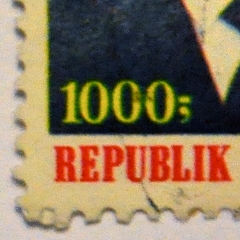
In sorting through stamps from the 1980s and 1990s from dozens of countries, I'm intrigued by the stamps that portray dictatorial leaders. Nearly all of them have been deposed since the stamps' issuance and some have been in the news throughout the Arab Spring (Summer/Fall/Winter). For me these stamps represent a bygone era, like my CCCP or Jugoslavia stamps, but certainly not an era that can not be repeated.
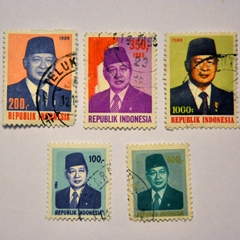
This is Suharto. Despite being a military dictator, he was a pal of the United States and other non-communist countries throughout the Cold War. He ruled Indonesia for 32 years until he resigned in 1998 after international disgrace over the deaths of 100,000 people in East Timor's struggle for independence.
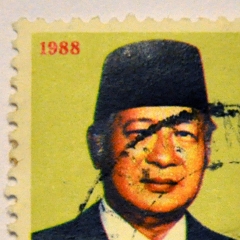
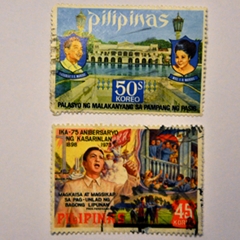
This is the Philippines' former president and his shoe collecting wife Ferdinand E. and Imelda Marcos. F.E. Marcos was president from 1965-1986. During that time, he allegedly embezzled around $5 billion from the country (his cronies also embezzled ridiculous amounts of money too). Victims of torture and family members of the some 1500 executed people under his rule were awarded about $2 billion in reparations, but as the money was in the United States, they didn't get the overwhelming majority since the U.S. wouldn't release the money.
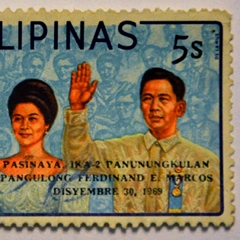
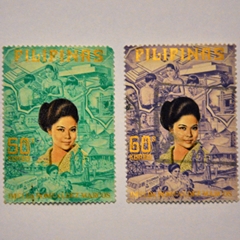
That Imelda was a looker though. Yikes!
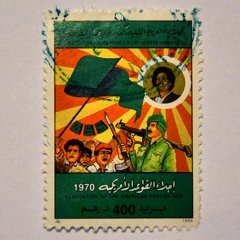
This is media darling Muammar Gaddafi, successively the Prime Minister, Chairman of the Revolutionary Command, Secretary General, and Brotherly Leader and Guide of the Revolution of oil rich Libya (42 years of rule). He of course was executed after capture back in October, 2011 by revolutionary forces aided by NATO.
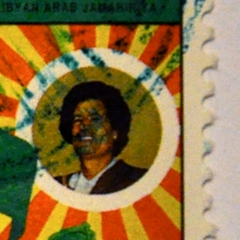
Brotherly Leader is portrayed here as the sun bringing light to his country.
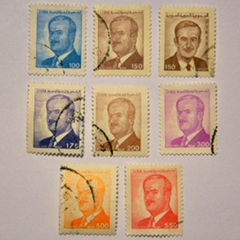
Hafez al-Assad is the father of current embattled Syrian president Bashar al-Assad. Hafez was the president of Syria for 29 years and was credited with building up the nation's infrastructure, opening it up to international trade, and ensuring women's equal status in the country. On the flip side, he was deeply criticized for the political repression he exerted on the Sunni Muslim population like the Hama massacre where between 10,000 and 40,000 men, women and children were killed by the military in the month of February, 1982. The news today continues to report on Bashar's current attacks, arrests and torture of dissident groups in Syria where over 5000 civilians have been killed in the past year.
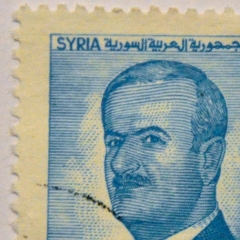
I find the stamps to be remarkable demonstrations of how narrow our view of reality is. The pictures represent temporal power that span decades, but even today we see that all of them are dead (I think Imelda might still be alive). Sure, their legacy continues in many respects, but they have nothing now. Was it worth killing and torturing thousands of their own countrymen to maintain strangleholds over their countries? For embezzlement?
Now I need to come clean. Who am I to judge them? Their actions, vile and corrupt, draw easy condemnation. But if we consider the nations that they controlled we may discover that they held them together when democracy could not. Consider Syria for a moment - the majority of the population is not educated and they are Sunni Muslims who can be swayed into fundamental and perhaps violent actions against the minority. The Philippines continue to try to find peace between the Catholics and Muslims while at the same time trying to provide an infrastructure for booming cities and outlying and impoverished villages - not an easy nation to govern. How would Canada respond if oil-rich Alberta tried to secede? Perhaps not as Indonesia did with East Timor, but I can imagine it wouldn't be pretty. Would Libya have been better off allowing foreign oil companies into the country? Nigeria tells us probably not. I can not excuse their actions, but I can not speak negatively about their legacy without offering some sober reflection.



No comments:
Post a Comment